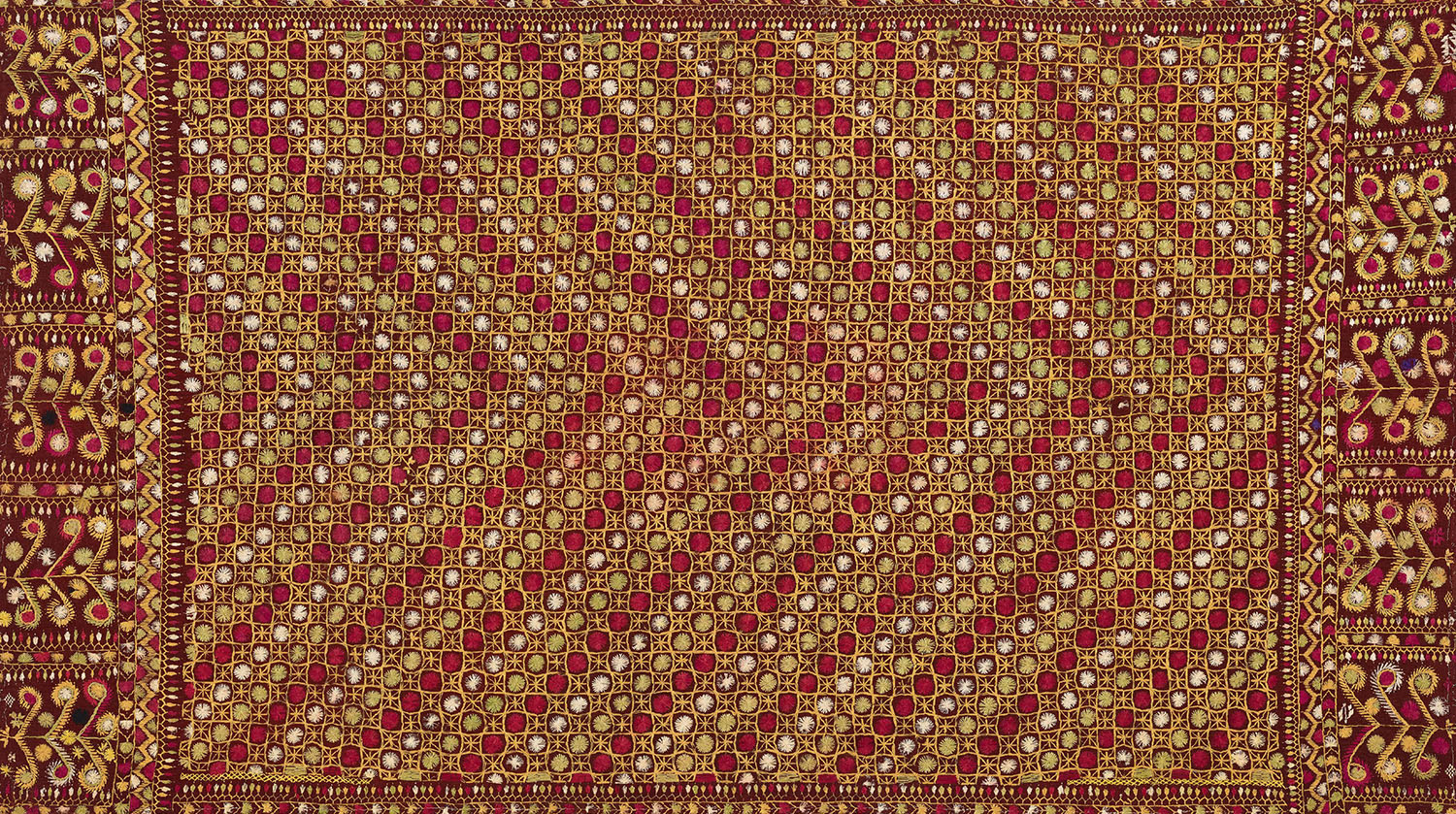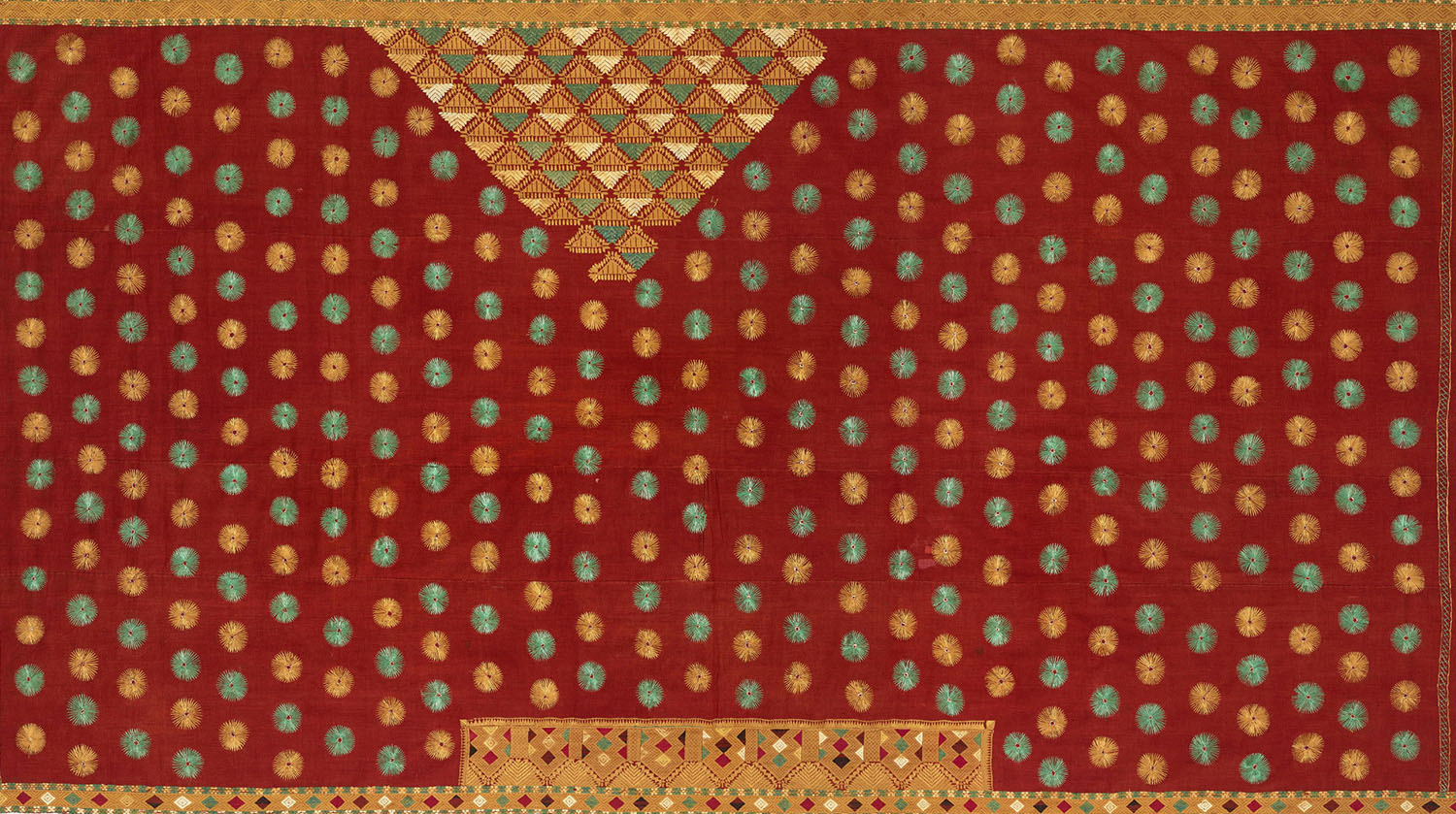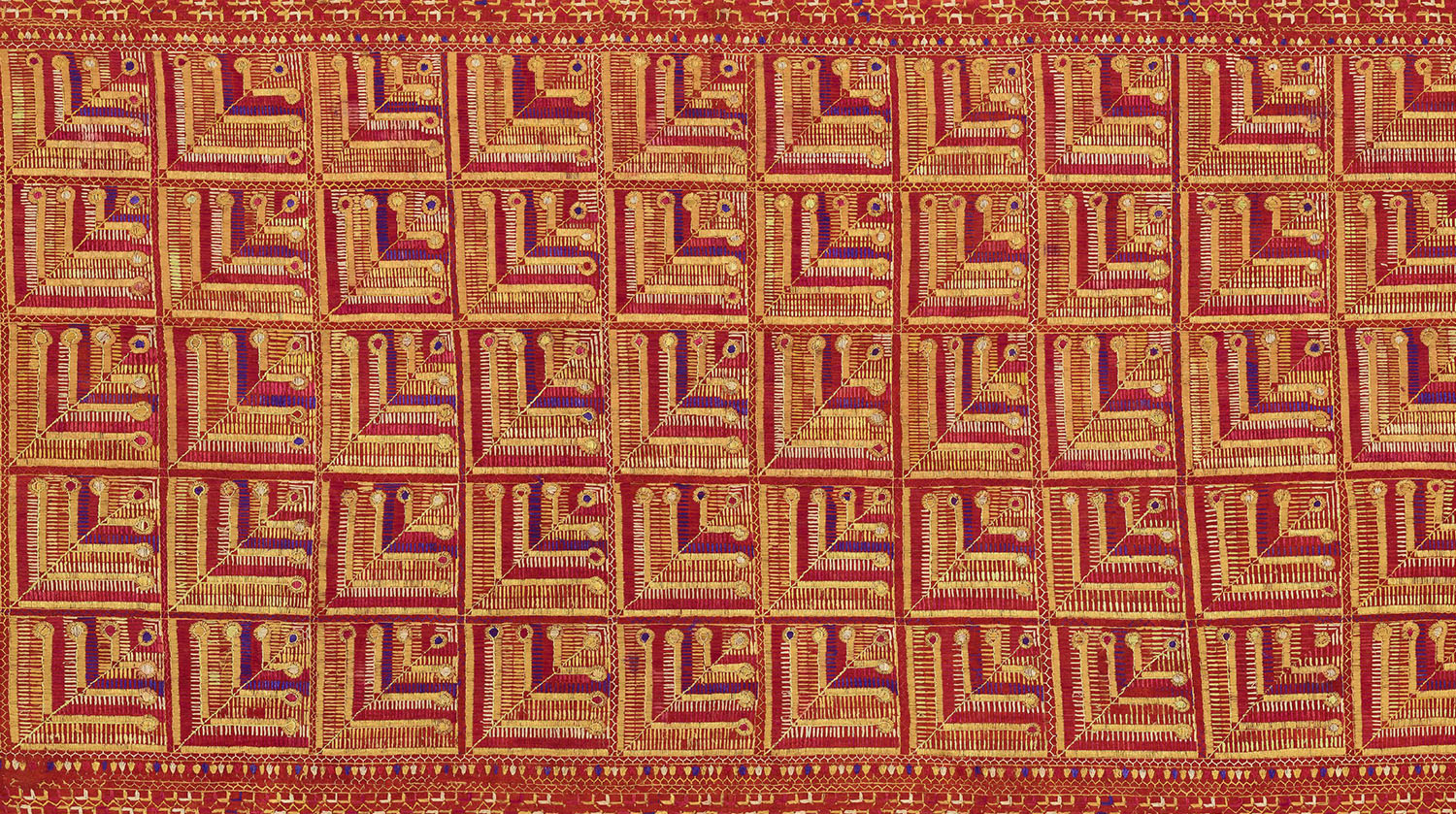ARTICLE
Phulkari
A hereditary embroidery tradition, phulkari was historically practised by women of the Punjab region in present-day India and Pakistan. It is a form of counted-thread embroidery recognised by its neat, regular patterns of geometric and natural motifs, whose name translates to ‘flower work’ in Hindi and Punjabi. Embroidery was traditionally considered an integral skill for women in the region, and phulkari garments came to be closely associated with major events in their lives, particularly marriage. In the medieval and colonial periods, girls would initially learn to embroider small garments like odhinis or scarves for themselves, and as they grew older, produce chaddars or shawls to be handed down to younger generations of women in their families. Phulkari shawls are often gifted to brides on wedding days, especially by maternal relatives.
The origin of the craft is debated, with some scholars suggesting that it was introduced to India from Central Asia by the Jat community in the late medieval period, while others state that the craft was born of influences from Persian gulkari embroidery designs. Phulkari embroidery and the traditions surrounding it have been mentioned in the Sikh holy book Guru Granth Sahib, and the eighteenth-century Punjabi epic Heer Ranjha.
Phulkari embroidery is done using a running stitch with brightly coloured untwisted silk thread historically imported from Kashmir and Bengal. It uses a base of coarse handwoven cloth called khaddar (or khadi), typically comprising strips about half a metre wide, or less, stitched together. In most cases, the khaddar is traditionally dyed red using plant-based dyes obtained from palash (Butea monosperma) flowers, madder root (genus Rubia) or the bark of acacia (genus Acacia) trees. Embroidery threads are often yellow, orange or pink; darker colours like black, brown and green are less frequently used, and blue rarely.
Despite its name, phulkari embroidery includes the depiction of animals and geometric forms in addition to flowers. The floral imagery used in phulkari includes marigolds, jasmines, lotuses and Tree of Life motifs. Modern motifs such as trains, trucks and cars have also found their way into phulkari patterns. The counted-thread method also lends phulkari designs a floral symmetry. In some cases, the embroiderer deliberately breaks the geometrical pattern in a small area, exposing the base fabric below. These are known as nazarbuti motifs and are meant to ward off misfortune for the wearer.
Shawls and wraps traditionally made with this craft are also called phulkaris, as the embroidery is their main feature. There are various types of phulkari, distinguished by their size, style and ceremonial value. The chope, made with a reversible, double darning stitch, is the largest and of the most ritualistic importance in Punjabi culture, as it is embroidered by a bride’s grandmother, who presents it as a wedding gift to be worn by the bride during the marriage ceremony. Others include the sainchi phulkari from the Bathinda and Faridkot districts; the blue-based nilak phulkari embroidered in red and yellow; the thirma phulkari made on a white base; the shishedar phulkari embellished with glass pieces; the til patra phulkari made with patterns of sesame seed motifs; and suber phulkari, which is embroidered only in the corners. Bagh embroidery, which uses an all-over design where the base is completely obscured, is sometimes regarded as a type of phulkari, but this and its subtypes are distinct textiles.
Prior to British rule in South Asia, phulkaris were not produced for commercial purposes but circulated as heirlooms in what is now Pakistani Punjab, mainly in the Peshawar, Sialkot, Hazara, Rawalpindi and Jhelum districts. From the nineteenth century onwards, embroidered shawls began to be given to British officers as tokens of goodwill. This period also saw the beginning of the commercial application of the craft on other garments, such as coats for women buyers living in cities. Following the Partition and the violence faced by Punjabi women in its aftermath, phulkari embroidery declined in India and Pakistan through the 1950s. Moreover, developmental agendas drafted by both countries in the post-Independence era depended on the rampant mechanisation of the goods and services sector, which pushed local craft traditions into further oblivion.
The 1980s and 1990s, however, heralded a revival for India’s art and craft traditions. Encouraged by a robust economy and counterculture movement against the West, the Indian government and NGOs made concerted efforts to revive phulkari and make it commercially viable. Women artisans were given skill-based training and financial support from banks and other government organisations like the National Bank for Agriculture and Rural Development (NABARD), Khadi and Village Industries Commission (KIVC), the Ministry of Textiles and the Small Industries Development Bank of India (SIDBI). Furthermore, the formation of self-help groups during this period encouraged women to form clusters and embroider at home for fashion designers and NGOs such as the Nabha Foundation, which in turn also played a major role in supporting local artisans by expanding the market presence of phulkari embroidery and design.
Today phulkari is produced mainly in Gurdaspur and Patiala, India, and is applied to several types of Indian garments, particularly dupattas, kurtas, blouses and saris, using various cotton fabrics as a base.
Bibliography
Ghose, Ruchira. Mapping Indian Textiles: Approaches to Display and Storage of Indian Textiles in Public Museums. New Delhi: Indira Gandhi National Centre for the Arts, 2017.
Gupta, Anu H., and Shalina Mehta. “Patterns of Phulkari: Then and Now.” Bonfring International Journal of Industrial Engineering and Management Science 4, no. 4 (2014): 179–85. https://doi:10.9756/bijiems.6133.
Hali. “Phulkari exhibition, Turin.” Accessed May 31, 2016. https://hali.com/news/phulkari-exhibition-turin/.
Lal, Krishna. Phulkari: From the Realm of Women’s Creativity: A Tradition of Handmade Embroidery of Punjab and Haryana: Selected Pieces from the Archives of IGNCA. New Delhi: Indira Gandhi National Centre for the Arts, 2013.
Mason, Darielle, and Cristin McKnight Sethi. Phulkari: The Embroidered Textiles of Punjab from the Jill and Sheldon Bonovitz Collection. Philadelphia Museum of Art, 2017.
Nabha Foundation. “Women Empowerment Through Phulkari Program.” Accessed August 23, 2021. https://thenabhafoundation.org/women-empowerment/.
Punjab Small Industries & Export Corporation. “Phulkari.” Accessed August 23, 2021. https://psiec.punjab.gov.in/newweb/phulkari.html.
Ranjan, Aditi, and M. P. Ranjan. Handmade in India: Crafts of India. New Delhi: Mapin, 2007.
Strand of Silk. “Technique to Make the Vibrant Phulkari Motifs.” Accessed August 23, 2021. https://strandofsilk.com/journey-map/punjab/phulkari-embroidery/production-technique.









